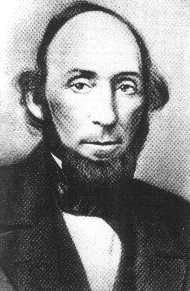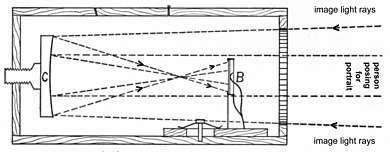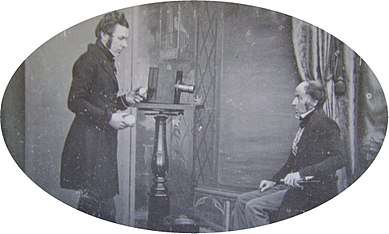John Johnson (inventor)
John Johnson (May 28, 1813 – May 3, 1871) was an instrument maker of dental supplies. He was a nineteenth-century pioneer photographer and an inventor. He made with Alexander S. Wolcott the world's first commercial portrait studio.
John Johnson | |
|---|---|
 circa 1870 | |
| Born | May 28, 1813 |
| Died | May 3, 1871 (aged 57) |
| Nationality | American |
| Occupation | Mechanic |
| Known for |
|
Early life
Johnson was born in Saco, Maine on May 28, 1813. His father was William Short Johnson.[1]
Mid life
Johnson lived his childhood and got his initial schooling in Pembroke, New Hampshire. After high school when a young man he worked for a watchmaker in New York City for a few years. Later he went into a business with Alexander Simon Wolcott, an instrument maker, and they formed a partnership with their photography firm in New York City.[2]
Photography

Johnson took to Wolcott on October 6, 1839, a detailed copy of the specifications on Louis Jacques Mande Daguerre's method of capturing a likeness of a person.[3][4] Wolcott was familiar with the mechanics of optics and experimented on improving Daguerre's basic methods of using lenses.[5] Wolcott came up with the concept that exposure time could be reduced by an improvement on the mechanical arrangement of the image focusing process.[6] This was by using a concave reflector of a 3–4 inch diameter that produced a short focus length.[7] The focused image was formed onto a chemically treated silver surface that was sensitive to light. The image stored on this chemically treated plate of about 2 by 2.5 inches could hold the picture indefinitely.[8]
Wolcott then made a camera that day with improvements on Daguerre's method.[2] The camera was a wooden box 15 inches long, 8.5 inches high, and 8 inches wide. There was a 7-inch concave mirror in the back of the camera.[9] The camera was constructed so that it had a large opening in front where the light rays of the person of the portrait passed through an aperture. The photo-sensitive 2 inch exposure plate was in a detachable frame in the center of this aperture opening, just inside the box. The operator of the camera would set up the focusing of the portrait picture on an unsensitized plate first. Then once the camera was focused with all of the mechanical items involved, then the camera operator would replace the focusing plate with the sensitized plate to take the picture.[9]

Photography historians Dr. Robert Taft and Patrick Robertson stated that Wolcott took a picture of Johnson as the first portrait in the world on October 7, 1839.[10][11][12][13] On March 4, 1840, they opened the first studio in the world as a commercial enterprise for taking pictures of people.[8][14][15] The customer would sit for their likeness to be captured on a permanent medium for future viewing.[16][17] The commercial photography studio was located in New York City at Broadway and Chamber Street.[18] Johnson with Wolcott created the world's first photography portrait studio as a business.[19][20][21][22] They opened their commercial daguerreotype photography portrait studio in March 1840.[23][24][25]
Wolcott's camera technology was taken to London by Johnson's father, William S. Johnson, in February 1840. A European franchise financial arrangement was worked out by W. S. Johnson with Richard Beard, a coal merchant and entrepreneur.[18][26] They hired John Frederick Goddard, a chemist and lecturer in optics. Goddard came up a chemistry formula to make the image plate sensitive to light so that an image would develop on it much faster than the daguerreotype cameras of the time.[27] The image plate used iodine chloride to make the plates sensitive to light, which helped to shorten the camera exposure time. The concave mirror reflector improvement and the photo-sensitive plate were the key innovative features Wolcott based his 1840 camera invention on that made portraits a possibility. This made exposure time to as low as a few minutes in bright sunlight, and since a person could be still for that long it make portraits possible using this state-of-the-art photography.[28][29] Beard then opened the first public portrait studio of Europe in London in March 1841,[27] the Daguerrean gallery at the Polytechnic Institute.[30] Beard developed franchises of portrait studios throughout England.[31]
Later life
Johnson died on May 3, 1871, in Saco, Maine.[32]
References
- Rinhart, Floyd; Rinhart, Marion (April 1977). "Wolcott and Johnson; Their Camera and Their Photography". History of Photography. Benezit Dictionary of Artists (Oxford University Press): 99–109, 129–134.
- Heathcote 2002, pp. 87–89.
- "Next Year Will Be Celebrated The Centennial of Photography". The Times-Independent. Moab, Utah. November 24, 1938 – via Newspapers.com

- Simkin, David (2005). "John Johnson (1813–1871)". Derbyshire Photographers' Profiles. Retrieved August 14, 2017.
- Watson, Elmo Scott (June 13, 1940). "Again is Raised the Question of Who Made the First Camera in the U.S." The Times-Independent. Moab, Utah. p. 2 – via Newspapers.com

- Watson, Elmo Scott (November 25, 1938). "The First Portrait". The Pleasant Grove Review. Pleasant Grove, Utah. p. 7 – via Newspapers.com

- Taft 2008, p. 33-35.
- Robertson 2011, p. 580.
- Gernsheim 1955, p. 91.
- Taft 2008, pp. 33–35.
- Watson, Elmo Scott (November 25, 1938). "Photography and the American Scene". The Ironwood Times. Ironwood, Michigan. p. 10 – via Newspapers.com

On October 7, 1939, Wolcott made a successful portrait of Johnson and this Taft calls the first.
- Watson, Elmo Scott (November 24, 1938). "The First Portrait". The Cambridge City Tribune. Cambridge City, Indiana. p. 2 – via Newspapers.com

On October 7, 1939, Wolcott made a successful portrait of Johnson and this Taft calls the first.
- Watson, Elmo Scott (June 14, 1940). "Took The First Photographic Portrait". Piute County News. Junction, Utah. p. 6 – via Newspapers.com

Wolcott, who was an instrument maker and manufacturer of dental supplies, took a daguerrotype of his partner, John Johnson, on October 7, 1839, according to Taft, and this was the first photographic portrait.
- McGraw-Hill 1969, p. 459.
- Neblette 1949, p. 12.
- Kane 1997, p. 414.
- Glenner 1990, p. 11.
- SPSE 1957, p. 6.
- "Timeline". The History of Photography Archive. 2017. Retrieved August 14, 2017.
- "America's First Look into the Camera: Daguerreotype Portraits and Views, 1839–1862". Library of Congress. 2017. Retrieved August 14, 2017.
In 1840, the first commercial portrait gallery, New York's Wolcott and Johnson, used large mirrors mounted outside the studio to project as much sunlight onto the customer as possible, in a sitting that could last for as long as eight minutes.
- Karad 2014, p. 49.
- "Early Portraiture". The Central News. Perkasie, Pennsylvania. December 30, 1897. p. 4 – via Newspapers.com

- Marzec 2004, p. 49.
- Martin 1988, p. 34.
- PJA 1868, p. 175.
- Chaudhuri 2007, p. 64.
- KodakMuseum 1989, p. 21.
- Coe 1978, p. 18.
- Rosenblum 1997, p. 196.
- "Beard's Coloured Photographic". The Guardian. London, England. May 18, 1850. p. 4 – via Newspapers.com

- "New York Correspondence". Photographic Journal of America. 5 (49): 175–177.
- Heathcote 2002, p. 87.
Sources
- Chaudhuri, Arun (2007). Indian Advertising:1780-1950. Tata McGraw-Hill Education. ISBN 978-0-07-060461-2.
In March 1840 Alexander S. Wolcott and John Johnson opened the first public portrait studio in New York. In 1841 Richard Beard having acquired the exclusive rights for Wolcott's camera in Britain opened the first public studio in Europe.
CS1 maint: ref=harv (link) - Coe, Brian (1978). Cameras: Daguerreotypes to Instant. Crown Publishers. ISBN 978-0-517-53381-9.CS1 maint: ref=harv (link)
- Gernsheim, Helmut & Alison (1955). The history of photography. Oxford University Press.
Being able to take portraits in as 'short' a time as from hours to 5 minutes, Wolcott and Johnson had opened the world's first 'Daguerrean Parlor' in New York City at the beginning of March 1840.
CS1 maint: ref=harv (link) - Glenner, Richard A. (1990). The American dentist. Pictorial Histories Pub. Co. ISBN 978-0-929521-05-3.
He also developed a system of photographic studio lighting in February 1840 and on March 13, 1840 opened the world's first commercial photographic studio. Wolcott made dental instruments and equipment with his partner, John Johnson.
CS1 maint: ref=harv (link) - Heathcote, Bernard & Pauline (2002). A faithful likeness. B. & P. Heathcote. ISBN 978-0-9541934-0-9.CS1 maint: ref=harv (link)
- Kane, Joseph Nathan (1997). Famous first facts. H.W. Wilson. ISBN 978-0-8242-0930-8.
#5813. The first commercial photography studio in the world was opened on March 4, 1840, in New York City by Alexander S. Wolcott and John Johnson. On May 8, 1840, Wolcott received the first photography patent, for “a method of taking likenesses by means of a concave reflector and plates so prepared that luminous or other rays will act thereon.” The photographs, 2 by 2.5 inches, were not reversed, as were daguerrotypes with refracting lenses.
CS1 maint: ref=harv (link) - Karad, Ashok (27 March 2014). Clinical Orthodontics. Elsevier Health Sciences. ISBN 978-81-312-3168-5.CS1 maint: ref=harv (link)
- KodakMuseum (June 1989). The Story of popular photography. Trafalgar Square Pub. ISBN 978-0-943955-15-5.CS1 maint: ref=harv (link)
- Martin, Elizabeth (1988). Preserving Old Photographs. Collins. ISBN 978-0-00-412142-0.CS1 maint: ref=harv (link)
- Marzec, Robert P. (2004). The Mid-Atlantic Region. Greenwood Publishing Group. ISBN 978-0-313-32954-8.CS1 maint: ref=harv (link)
- McGraw-Hill (1969). Focal Encyclopedia of Photography. McGraw-Hill.CS1 maint: ref=harv (link)
- Neblette, Carroll Bernard (1949). Photography. D. Van Nostrand company inc.
Alexander Wolcott ... He opened a studio for the making of Daguerreotypes in New York City on March 4, 1840. This was the first commercial photographic establishment in the United States.
CS1 maint: ref=harv (link) - PJA (1868). Photographic Journal of America ... Benerman & Wilson.CS1 maint: ref=harv (link)
- Robertson, Patrick (11 November 2011). Robertson's Book of Firsts. Bloomsbury Publishing. ISBN 978-1-60819-738-5.
The first, a profile portrait of New York dental supplies manufacturer John Johnson, was taken by his partner Alexander S. Wolcott on 7 October 1839. It was a mere 9 mm square. The partners open the world's first photographic portrait studio the following March.
CS1 maint: ref=harv (link) - Rosenblum, Naomi (1 February 1997). A world history of photography. Abbeville Press. ISBN 978-0-7892-0028-0.CS1 maint: ref=harv (link)
- SPSE (1957). Photographic Science and Engineering. Society of Photographic Scientists.
Wolcott opened a portrait studio on March 13, 1840.
CS1 maint: ref=harv (link) - Taft, Robert (November 2008). Photography and the American Scene. Acls History E Book Project. ISBN 978-1-59740-586-7.CS1 maint: ref=harv (link)